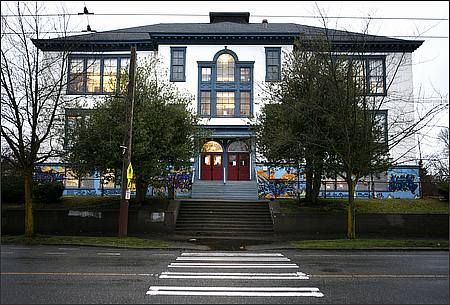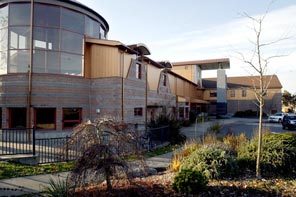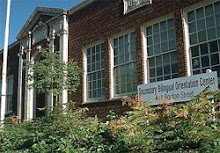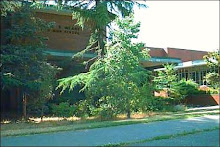Excerpt From an Open Letter to Arne Duncan from Herb Kohl
We have come far from that time in the '60s. Now the mantra is high expectations and high standards. Yet, with all that zeal to produce measurable learning outcomes we have lost sight of the essential motivations to learn that moved my students. Recently I asked a number of elementary school students what they were learning about and the reactions were consistently, "We are learning how to do good on the tests." They did not say they were learning to read.
It is hard for me to understand how educators can claim that they are creating high standards when the substance and content of learning is reduced to the mechanical task of getting a correct answer on a manufactured test." (Summer 2009)
Nova High School Relocated

Merit Pay
Laurie, in response to R. Weingartner, On Point, 1/26/10
Merit pay is an issue that is closely associated with charter schools and is a reiteration of the No Child Left Behind Act.
Basically, it requires that teachers pay be based on how well their students perform on standardized tests. For our students, it could be the new MAP test. With the No Child Left Behind Act, teachers and staff were pressured to teach much of the class work to the standardized tests. With so much focus on the test, many other parts of knowledge building, creativity and understanding of subjects and their synthesis with other knowledge had to take a back seat. For many students, teaching to a test meant that they were not able to reach their full potential which would have been far beyond the level of the tests.
No one wins in this situation.
Part of the fallout also is that if a teacher's pay is based on how well their students test, many teachers will want to teach in a school where they know that the students will perform well. Those schools are, for the most part, not the schools that are predominately minority in population.
Some students do not perform well on standardized tests for many different reasons and yet a teacher's pay can be tied to that student's performance. High stakes testing also puts pressure and stress on the students who become burdened with the thought that they need to perform well on one test. The test becomes a focus with little opportunity to explore and have fun learning, creating and synthesizing new thoughts and ideas.
Update: The Governor of Texas has decided to opt out of the Race to the Top funding because of the ineffectiveness of the merit pay program that was in effect for three years inthe state.
Update: March 8, 2010 Principal to be removed from school in Wasington State due to low WASL scores.
What Is a Charter School?
A charter school can expel any student that it doesn't believe fits within its standards or meets its level of expectation in terms of test scores. If the student is dropped off the rolls of the charter school, the money that was allotted for that student may or may not be returned to the district at the beginning of the next year. That is dependent upon the contract that is established by each district.
Also, according to a recent (June 15, 2009) study by Stanford University's Center for Research on Education Outcomes (CREDO), charter schools do not necessarily perform any better than public schools. In fact, 37 percent performed worse. Forty-six percent demonstrated "no significant difference" from public schools. Only 17 percent of charter schools performed better than public schools.
Thomas Jefferson
The Broad Foundation
The Broad Foundation claims to be a philanthropic organization, created by billionaire Eli Broad.
The Broad Foundation supports privately run charter schools and actively develops a system of charter schools in urban areas.
Broad claims it engages in "venture philanthropy":
"Our Approach to Investing: Venture Philanthropy. We take an untraditional approach to giving. We don't simply write checks to charities. Instead we practice 'venture philanthropy.' And we expect a return on our investment."
Many of us have discovered the Broad Foundation's presence within SPS and are requesting an explanation for why it is here and what its' objectives are.
Seattle has three "Broad Residents", and two Broad graduates now working within SPS. One of them is our superintendent who is a graduate of the Broad Academy which trains superintendents, and is also on the Broad's Board of Directors.
Another Broad graduate and a onetime Broad resident in SPS, Brad Bernatek, is now Director of REA, Research, Evaluation and Assessment within SPS. That department is responsible for student statistics including enrollment, demographics, evaluation and standardized testing.
The Broad Foundation provided Dr. Payzant, also a Broad graduate, to be a part of our superintendent’s yearly review in 2009.
Broad recently gave SPS a $1M "gift." That money is now in the hands of the Alliance for Education and no one knows how the money is being spent.
All in all the Broad Foundation has been quite generous to the Seattle Public School system and as Eli Broad states himself, he expects a return on his investment.
Broad also supports and actively promotes mayoral control of school districts. Eli Broad's preferred model of mayoral control means that the mayor selects the school board members and superintendent who are therefore unelected and are beholden only to the mayor, not the people of the city. It then becomes a school district that is run by one person, the mayor, with heavy influence by the Broad Foundation through developed relationships with that individual.
Update: A Detroit School District employee found accepting money from the Broad Foundation.
"Let the games begin: Detroit Teachers vote to unanimously join the current Detroit Public School District in their suit against Robert Bobb".
Update: The Broad - Rhode Island connection.
Rhode Island has had the dubious distinction of making national news recently for the draconian firing/scapegoating of an entire school of teachers. Is it a coincidence that the new education commissioner for R.I., who is pushing the state to do whatever it takes to qualify for federal "Race to the Top" dollars, is a "Broad Superintendents Academy" graduate, Deborah Gist?
Dan Weil
Dollars and Sense
December, 2009
What the Gates Foundation Is Doing: The MAP Test
The Gates Foundation supports, and pays for, high stakes testing which is tied to merit pay.
The Bill & Melinda Gates Foundation has given Seattle Public Schools a total of $9M this year for additional testing. We have not been able to find out the details of this testing yet. We don't know what the test is, what the test is to determine, who is administering the test and how the results of the tests are to be used.
UPDATE: We have heard that the Gates "gift" is funding the new computerized, standardized "MAP" tests the district is administering this year to all students, from as young as kindergarten to grade 9. MAP stands for "Measures of Academic Progress™" (yes, it is a trademarked product) and will be administered to the kids three times during the school year. The test can take as much as two hours each session, according to the district's official announcement letter.
A number of questions come to mind: Is this the best use of the students' school time? Is it appropriate to make children as young as five who can't read take a standardized test on a computer? Is this the best use of such funds? Or would parents, students and teachers prefer to see money channeled more directly to the classroom, to create smaller class sizes, more enrichment opportunities, or to purchase new textbooks?
A SIDE NOTE: Another interesting connection is that our superintendent, Dr. Goodloe-Johnson, is on the Board of Directors for the company that has created and distributes the MAP test. There is $4.3M in the levy to pay for additional use of this MAP test in Seattle.
The Cooper Building: Program DIscontinued, 2009

Regarding Arne Duncan's Renaissance 2010
Most of the new experimental schools have eliminated the teacher union. The Commercial Club hired corporate consulting firm A.T. Kearney to write Ren2010, which called for the closing of 100 public schools and the reopening of privatized charter schools, contract schools (more charters to circumvent state limits) and "performance" schools.
Kearney's web site is unapologetic about its business-oriented notion of leadership, one that John Dewey thought should be avoided at all costs. It states, 'Drawing on our program-management skills and our knowledge of best practices used across industries, we provided a private-sector perspective on how to address many of the complex issues that challenge other large urban education transformations.'
Duncan's advocacy of the Renaissance 2010 plan alone should have immediately disqualified him for the Obama appointment."
Henry Giroux & Kenneth Saltman,
Obama's Betrayal of Public Education?
Truthout
The African American Academy: Closed 2009

Alternative Schools in Seattle
At this time, the alternative and nontraditional schools in Seattle are basically under siege. Many schools have been closed, marginalized or split apart, including the Accelerated Progress Program (APP) for highly gifted kids, the Center School, Nova, Summit, the African American Academy, SBOC and AS-1. There is also a plan for an Alternative School Audit by SPS in October, 2009.
We see these alternative programs as viable options to the traditional school approach to education. For this reason many of us believe that with the support of these programs, there is no need for privatized charter schools.
Governor Gregoire and our state representatives are speaking to Arne Duncan about our alternative schools and that they meet the requirement of charter schools and should be considered in providing Race to the Top funds to our state.
Summit K-12: Closed 2009

An alternative school
Please Note
Meg Diaz, a parent, did a brilliant presentation to the school board in January regarding the school closures, the demographics of Seattle and why it didn't make sense to close the schools.
See: http://sites.google.com/site/seattleschoolsgroup/meg-diaz-analysis
Unfortunately, the school board paid no attention to Ms. Diaz or their own reports and instead chose to believe the numbers presented by the superintendent's CFO, Don Kennedy who previously worked with our superintendent in Charleston, and Brad Bernatek our Broad graduate and Director of REA, Research, Evaluation and Assessment who also handles the demographic data for SPS.
Two schools were closed that, per their own report, would see an increase in school aged children of anywhere between 31%-100% between 2008 and 2012. See page 11 of the DeJong report titled "Seattle Public Schools: Enrollment Projections Report". Those two schools were TT Minor Elementary School and Meany Middle School.
After the closures, Ms. Diaz decided to investigate the administrative cost within the Stanford Center and came up with surprising results. While the superintendet was rifing teaches and staff and closing schools, staff was growing within the Stanford Center and particularly in our superintendent's office where yet another Broad graduate was hired as one of the superintendent's administrative assistants.
Posted on October 6, 2009: The new assignment plan just came out and the proposal is to re-open five school buildings. Between closing five school buildings, shuffling students to different schools and now proposing the re-opening of five buildings within a year's time speaks volumns about the lack of competency of our superintendent and her chosen staff.
We have now wasted money closing five schools, moving students, equipment and materials around just to re-open five school buildings.
The cost of re-opening five of these buildings is as follows:
Sand Point: $7M
Viewlands: $11M
Old Hay: $7.5M
Mc Donald$: $14.9M
Rainier View: $7.4M
Total so far: $47.8
The superintendent, along with the school board, plan to take the next capitol levy money, BEX III, to be voted on in 2010 that was to go to the maintenance and seismic upgrades of our school buildings, which would make them safer, and instead use the money to re-open these previously closed buildings.
The decision to close schools last year and close or relocate programs came down from our superintendent's office quickly and there was little time for debate or understanding of what the ramifications would be. It is my opinion that again, we need to have time to evaluate what cost can wait and how these cost can be phased so that we can not only make our existing buildings safer but also provide adequate space for all of our students.
There is also stimulus money that other school dristricts have been able to acquire to upgrade their school buildings through FEMA grants. These grants, part of a Disaster Mitigation Fund, are being used to make school buildings safer. I had presented this information to the school board and superintendent but no action was taken at the time.
I will provide updates on the effort to once again get SPS to pay attention to this opportunity.
Please send comments or ideas to us or share your opinions below. We want to hear from you. All positive and constructive input is of value.
DT
Priscilla Gutierrez, Huffington Post comment
Lowell Elementary

The Lowell APP program was split with half of the students sent to Thurgood Marshall.
Our Declaration
In the current national discussion about education reform, the loudest voices are not necessarily those of the people who are directly affected by what happens in our schools – the students, parents, teachers and school communities themselves.
We are parents with children in public schools. These are our kids, their teachers, our schools. And we would like to be heard.
What’s more, the message coming from the current league of reformers is largely negative, much talk about what’s wrong with our schools, but little discussion of what public schools and teachers are doing right, and what they could do even better if given full support.
Can our public schools be improved? Absolutely. But that begins with fully funding our schools and believing they can work.
We believe they can, when given the chance.
We also believe that too many of the latest proposed education reforms are too punitive and are not changes for the better.
We believe there are valuable aspects of public education worth preserving and supporting, beginning with the very principle itself – free public education for every child in the country. We believe this has always been a noble goal and one that we’re not willing to give up on.So we have created a Declaration of Support for Public Schools.
We invite others across the nation who share our vision for public education to sign on to our statement, to send a message to the president, education secretary and school district officials throughout the country.
The message is simple:
Let’s fix what’s broken, but don’t break what isn’t.
And do not impose detrimental changes on our schools and children in the name of “reform.”
Sincerely,
Sue Peters, Dora Taylor
Seattle Public Schools parents
May 2010
Saturday, December 19, 2009
What Happened in Oakland is Happening Now in Seattle
I just discovered your blog this morning when my hit counter showed that someone was directed to my blog via yours.
Local control was just returned to my public school district (Oakland) in late June, after being subjected to six years of Broad-trained leadership, courtesy of our state superintendent. The experience left a sour taste in everyone's mouth and permanent damage was definitely done during their stay. The top level (state administrator) is gone now and I think our new superintendent is clean, but a few Broad Residents who worked in the district during that time still lurk around the corners.
The thing that is freaking me out this week is the revelation about a $4 million donation given to Learn NY that covered propaganda costs for preserving mayoral control in NYC. Limits need to be put on this man (Bill Gates); his near-infinite wealth gives him a frightening amount of power. NO single human, no matter how rich or smart they are, or well-intentioned they think they might be, should have that much power.Gates is only one person, with one set of ideas, but he is so vastly wealthy that he can purchase whatever type of local and national educational policy he prefers. This country is still supposed to be a democracy, right? And what if the way to go that Gates imagines is right, is completely wrong? Putting it in perspective, consider that for Gates (with a net worth last listed by Forbes at $40 billion) a $4 million donation is the equivalent of a $5 donation given by a person who is making $50,000. In the world that dictates public policy, Gates has become omnipotent. We’re in dangerous territory when single individuals are unrestrained with buying public policy because they have unimaginable wealth.
Take care,
Sharonhttp://perimeterprimate.blogspot.com/
PS: Even lesser billionaires have an amount of power that we, as average people, can’t imagine... If Eli Broad ($5.2 billion) paid $4 million to buy propaganda that pushed a public policy he preferred, it would be the equivalent of an average person (net worth of $50,000) donating $38.46 to a cause they preferred.Where is the transparency? Where are the restrictions? Even political campaigns have those rules.
I asked Sharon about the Broad Foundation in Oakland and this was her response.
This is how the Broad Foundation took over our schools.
In 2003 a budget deficit required us to take a state loan, the conditions of which required the management of OUSD to be placed under state control. Our State Superintendent assigned state administrators to the district. We had three of them consecutively in six years, and all were Broad Superintendent Academy graduates. Once they took charge, they brought in a number of Broad Residents and appointed them to important positions, too. Just a couple of years before this happened, Eli Broad, along with his pro-charter friends, had been very generous to the State Superintendent's campaign. In return, he gave them OUSD to be their plaything. See "Eli's Experiment" by Robert Gammon.
The first thing these people did was to block public input. The elected school board had no power, the voice from the community was not solicited or listened to. OUSD was basically under the Broad Superintendents' authoritarian rule, and they consulted with people at the Broad Foundation regularly.
As the Center for Education Reform report says, this group wanted a "politics free zone." That means a situation with no public participation. This is exactly why this cabal likes mayoral control so much; it's much easier for them to be able to influence one person who is already ambitious, power-hungry and somewhat removed from the people, than it would be to convince 7, 8, 9, or 10 more-intimately-connected-with-the-average-person school board people to climb on their train.
You can read the report “National Model or Temporary Opportunity: The Oakland Education Reform Story.” It can be found at http://www.edreform.com/_upload/CER_Oakland_Education_Reform_9_07.pdf. I've written about it here: http://perimeterprimate.blogspot.com/2009/02/national-model-or-temporary-opportunity.html
The Broad leadership independently decided about, and rapidly implemented, school closures and other major permanent changes to our district. Their program of attack was called "Expect Success." Schools became portfolios and were assigned different colors (green to red) depending on their test scores. This clearly outlined and justified school elimination. Charter schools were permitted to spring up rapidly during this time. In a district that already had a problem with declining enrollment (people moving to the suburbs to buy houses with cheap mortgage deals), this exacerbated things.
In the meantime, veteran site administrators were driven out because they weren't willing to embrace what was being done. Hiring preference for principalships was given to people who were involved with New Leaders for New Schools, an organization originally launched by Broad which offered lots of extra perks to entice people to apply (like no tuition, guaranteed placement, salary while learning, etc). For instance, people who were involved with the principal training program at UC Berkeley couldn't equally compete for positions. Other than to produce an unraveling of what had been before, this strategy was, I'm sure, to make sure the desired mentality was planted broadly across the district. The central office structure was completely revised. You would talk to someone in a downtown office and the next month they would be gone, and a month after that, the new person would be gone. It was that type of ongoing disruption. Institutional memory was wiped out. Hardly anyone knew anything; it was all being created from scratch. Even though the district has struggled for a long time, and could always have definitely been run much better, what happened during those six years heightened the turmoil. The top leaders kept themselves away from having to listen to the community and it's views or needs. In the end, it's pretty much concluded that the focus of this group was to upset the scene and to implement a district of their own dreams. As education reporter Katy Murphy wrote: “Although financial problems triggered the Oakland school district's takeover, the state administration appeared to be more focused on redesigning schools and overhauling central office services than on stabilizing the district's finances.”
Here's her article with more details:
http://www.insidebayarea.com/oakland/ci_12753927http://perimeterprimate.blogspot.com/2009/05/same-old-mud-pies.htmlhttp://perimeterprimate.blogspot.com/2009/03/if-i-was-billionaire.htmlhttp://perimeterprimate.blogspot.com/2009/03/battle.html
(Don Shalvey just took a position w/the Gates Foundation)
http://perimeterprimate.blogspot.com/2009/03/is-it-fiction-or-not-not.htmlhttp://perimeterprimate.blogspot.com/2009/03/national-scene-on-local-scale.html
The siege that public education is under is extremely progressed at this point, and it’s been (and still is) very, very, very well-funded. Most people are unaware of what’s happening. The spirit of the teachers has been suppressed with the constantly repeated propaganda which nationally broadcasts their enormous “failings” over and over again. This is an intentional strategy to make them question their own worth and to break down the solidarity of the profession. Have you read The Shock Doctrine? I'm about half way through and highly recommend it. It talks about the movement of the corporatists, and how it was designed by Milton Friedman (the "intellectual architect") in Chicago several decades ago.
Also, you may be interested in this piece about Gates' domineering influence over world health programs. There are near exact parallels to the affect he is having on public education: http://www.ghwatch.org/ghw2/ghw2pdf/d1.3.pdf
Sharon
Friday, December 11, 2009
Seattle Public Schools: Budget Deficit Part Two
I sat in on the Audit and Finance Committee meeting today.
I was looking forward to hearing our CFO’s ideas on how the budget deficit could be rectified as he had suggested would happen in the school board meeting the night before. I was expecting some creative ideas that could be implemented, fat that could be cut, just about anything to get us back on our feet and boy was I amazed. Not impressed, just amazed.
Let me start at the beginning.
The people in attendance in the meeting were Maier, Sundquist, Carr, DeBell, Kennedy, our CFO, and a host of other folks from the district side who for the most part didn’t say a word but were there because….they needed to be there I suppose. Our tax dollars at work. There were eight of them at one point. The one person who was not in attendance was our superintendent and “CEO” as many liken her to be.
First the monthly reports were presented for September and October. I guess we’ll see November’s report sometime in the spring. There were a lot of numbers.
Something got picked up by DeBell about the 111 coaches that were part of the central administration costs. He asked how many were paid for by grants and maybe we could do something there to “help the debt”.
OK. A decent call. The district would get back to him on that by the end of the meeting. I didn’t stay until the end so I don’t know if that happened or not.
Another really hard question from DeBell, was the hiring freeze still in effect? Don Kennedy said that they would get into that later motioning to another person who later made a “presentation” to the board members. To make a long story short, that question never got answered. A simple yes or no would have been sufficient. Did Mr. Kennedy really not know? Hmmm.
Then DeBell asked about a $3M reconciliation that he had requested and had not received. Well, Mr. Kennedy would have to get back to him on that too.
I’m starting to wonder what this guy does all day. He certainly doesn’t prepare for his meetings, his big moments in front of the board. Or maybe they aren’t such big moments for him. Maybe he thinks that the board members will forget and move on just like with those rif numbers that DeBell asked for in two different meetings that were to substantiate the superintendent’s decision to fire teachers and staff. Another, hmmm.
Well, finally to the big anticipated moment that we had all been waiting for since the board meeting the night before, Mr. Kennedy’s ideas on how to rectify the deficit.
What we were handed was a copy of the PowerPoint that we had seen the night before. Everything was in really big letters, using an entire page for just a few words and not double sided. Boy, they sure do know how to save a buck downtown.
There was no new information, no breakdowns, just those numbers again in a really big font.
It was interesting that no one asked the obvious question. Why, when we are in a deficit, did the superintendent think that it was worth increasing the deficit by $9,284,000 (A number that you could see on the other side of the room on that piece of paper) in such a financially difficult time? Couldn’t the SAP have waited a bit? But that elephant in the room was never questioned about its’ presence.
The number for “Academic Assurances” was questioned by DeBell. How much would be on-going? Kennedy said that he would provide a breakdown…at another time.
I was thinking that one of the board members would have requested a breakdown for the SAP cost of $3,596,000 but no one did. Was I on another planet or was I the only one wondering where $3.5M goes to pay for the SAP for one year? I’m sorry, but in my profession, if a contractor comes to me with an invoice for $3M, I want a detailed explanation. Pronto.
So on page six in the largest font possible were five lines;
“Projected GAP” (shown just like that) $35,026,000
“New Student Assignment Plan” $9,284,000
“Budget Enhancements” (don’t you like that phrase?) 4,826,080
“TOTAL SHORTFALL” $49,136,080
By the way, on the bottom of every page were the words “Every student achieving, everyone accountable”. Hmmm
And now to the “Proposed Solutions” in huge letters on the next page.
“Delayering/Central Reductions” $6M (I kid you not)
And what is “delayering”? Well, first of all, it’s a pretty cool word don’t you think?
It is something that the Department of Finance learned about in a seminar, that hopefully was in town and not really in Texas, and it describes how many layers there are between the superintendent and the students. Well, fortunately in Texas there are only seven layers, which apparently is a good thing, and it also is in Seattle. Of course they will need to work further into that analysis but hey, doesn’t look like we need to cut any costs down here (meaning downtown).
The layers would be superintendent, CAO, directors, principals, assistant principals, teachers, students. I was wondering about all of the other people that surround each of these levels, like assistants for the superintendent and the staff for the CAO, but I guess that doesn’t matter. It’s a layering thing.
There was nothing about four day work weeks, a week off without pay each year or just plain layoffs, something that the rest of us have had to live through, just “delayering”. Fortunately DeBell and Carr did mention “furloughs”, which was a very nice way of putting it. Someone said that they would look into that. Who’s wants to put money on that actually happening?
Another term used by the presenter was “span of control”, yet another pretty cool term you can use at your next family gathering. It means that some managers might have two people who report to them and another manager might have 17 people who report to them. The number of mangers could be consolidated. OK. This is not rocket science. Just start culling through staff like the rest of us have had to and start the layoff’s.
Then came “WSS Cuts (Core staffing, Class Size, Weighting)” $6M
This meant free and reduced lunches, wouldn’t that be better than losing some of that bureaucracy(?) and discretionary funds. This would be up to each principal to figure out where they could, and would have to, cut their budgets. Don’t worry, we are all going to get to feel this pain. That is, everyone but out superintendent.
“Freeze on Purchases and Contracts” $3M
“Shifts to Grant Funding” $1M
“Translation Efficiencies” $1M
(That means having interpreters at all SPS meeting with the public. The proposal was to have them as requested.)
For some reason at this point someone from the district brought up the fact that they would look at summer school. No additional explanation was given.
“Reduced Extra-time/Overtime” $2M
“Non-essential Hiring Freeze” $2M
“Increased Revenue” $1M
Pay for play came up here, meal costs, rental of buildings and rental of instruments.
“Other Cost Savings” $4M
Mr. Kennedy would provide more detail about this (blah, blah, blah).
“Total Solutions=” $26M
Yeah right.
DeBell did bring up that in other countries there is a greater percentage of teachers as compared to school bureaucracy. He also suggested eliminating elementary school counselors and eliminating some security and replacing them with police officers.
Anybody ready to propose a state income tax?
But the best part was saved for last.
I was curious as to what the “Southeast Education Initiative” meant so I decided to stay for that presentation.
The handouts were distributed with great fanfare ( The Emperor’s New Clothes came to mind) and someone commented that it must have been written using invisible ink because there was nothing in the columns. No, Don Kennedy said, the columns would be “populated” tomorrow. So basically, that presentation was not quite ready yet. Oh well, maybe we’ll get that information when Don Kennedy finally gives us the analysis on the rif’s. The worst part, could it get any worse (?), is that DeBell said that the matrix didn’t include information that he had requested.
This entire presentation was sad.
In the real world, Mr. Kennedy would have been on the short list for folks to be laid off in the first round. But, he is the superintendent’s CFO who she brought with her from Charleston and her right hand man. He is apparently very influential and someone to be feared. What a sad state of affairs.
The board is working with one hand tied behind their backs with this guy. I just hope that they can free themselves of this and demand a real and professional accounting of our finances.
Thursday, December 10, 2009
Seattle Public Schools: Budget Deficit Part One
Instead of providing a blow by blow description I thought instead that it would be more interesting to read an exchange that I had with two people about the subject. It went as follows:
Me:
"OK. I have a question for everyone.
I was at the board meeting tonight. I did not give my testimony as intended but ceded my time to Chris Stewart who talked about how several of the schools receiving an award for most improved and recognized at the meeting tonight were alternative schools. It seemed more appropriate. I plan to testify about MAP in January.
Anyway, whenever I listen to our CFO talk, I learn something new and interesting. Tonight Don Kennedy talked about the budget gap this year. Last year the gap was $35M and this year it is $49M. Much of the difference is the SAP plan that for this year, for one year only, will cost us $9,284,000. There will be additional expense next year but I didn't note the projected cost. Kennedy included STEM in this amount. STEM cost $1,668,000 for the first year only as well. There will be additional cost next year for STEM. The central office budget made up the remainder. There was $4,391,000 for General Counsel and yet only $2,250,000 for math in the central office. I'm assuming that the lawsuits brought the counsel number up.
Kennedy said that they would come up with some ideas on how to decrease this gap in the finance meeting tomorrow which I plan to attend.
How could our superintendent cause so much pain to save $3M in closing schools and then turn around and spend $9M on the SAP when SPS already had a deficit that it couldn't close? And where was the board on this?
With such a deficit and such a big deal made about being over budget and having to rif teachers and close schools this year, how could our superintendent turn around and present a new SAP that just got us deeper into debt? Couldn't the new plan have waited until we were back on our feet financially?
This is not a rhetorical question.
Any thoughts?"
First respondent:
"Thoughts...Thoughts
MGJ and Kennedy were mum at the June 2009 School Board meeting when the board was looking for economy measures to reduce teacher RIFFING....Mum on the fact they were going to spend $10+ million on 111.5 academic coaches while the teacher RIF proceeded.
Money and these folks and plans ...I haven't a clue. {Ask Meg Diaz}"
Second Respondent:
"Dora - how does the nearly $50M cost incurred by injudicious closing of schools relate to the numbers you gave? Does the upward revised budget deficit reflect this? If not, where does this mistake show up in the numbers?
Am I naive to be astonished that this Sup is not being excoriated for the nearly $50 million school closure debacle? Is it fair to compare this mistake to the reasons that Olfshevske was induced to resign? After all, didn't the District have the demographic data BEFORE closures, that showed that too many schools were being closed?
When we compare the estimated savings for various decisions, the magnitude of suffering and hardships that decisions would cause, and the size of the annual District budget (now exceeding half a billion dollars), many of the biggest initiatives by this Sup (especially school closure, SAP) seem to me, on the balance like very bad ideas.Any thoughts on this?"
Me:
"Joan,
Good question about the money spent on closing and opening schools. That wasn't mentioned.
We have a budget gap of $49M as opposed to last year when the gap was $35M. That's a difference of $14M. $9M of that money was from the SAP and the STEM project at Cleveland.
Our superintendent might think of herself as a CEO but in my book, a CEO who spends money faster than we can make it should be fired, not given a bonus. That is unless you're head of AIG.
Interesting aside that the president of AIG is on the Broad board. Eli Broad has a financial connection with AIG. I believe that he sold some of the interest in his Broad/Kaufman company to AIG.
Anyway, I am digressing. The main point of this is, just like with the financial failure of this country, it's going to be the rest of us who take the brunt of our CEO/Superintendent's decisions by trying to figure out how each school will manage with even less money. Each school is now going to have to determine how they can cut back and still keep going. And if you don't believe me, ask your principals."
Wednesday, December 9, 2009
MAP Testing in Seattle
You should have in front of you two documents, “An Open Letter to Arne Duncan” by Herb Kohl and “The Rise of Venture Philanthropy and the Ongoing Neoliberal Assault on Public Education: The Eli and Edythe Broad Foundation” by Kenneth Saltman. Both documents can be found on the website Seattle Education 2010 and tie into what is happening within our school system in terms of MAP testing.
My attention was drawn to the MAP testing when I understood that kindergarten students would be tested on computers twice, maybe three times a year, to evaluate their academic progress, an idea that I find ludicrous at best. The MAP test which stands for Measures of Academic Progress is to be used to determine a student’s progress grades K through 9 and it is my concern that this narrow measure of academic achievement will be used in short order to evaluate a teacher’s performance which would be tied into the concept of merit pay. I have read Directors Sundquist and De Bell’s remarks in the press about how the superintendent’s raise is an example of what they would like to see follow in terms of merit pay for all teachers and by that I am greatly alarmed.
Not only is this test simply a snapshot of one day in the life of a student, a day that might be fraught with hunger, fear or general malaise, it is at this point a false representation of a student’s level of understanding of various subjects.
I have read and heard that the students already know how to manipulate the test so that they get easier questions and can finish the test more quickly. These students have learned that if a series of questions appears to be too difficult for a student, the questions become easier. This was to be a hallmark of this test, the ability for the software to adjust to the level of a student’s understanding of the subject matter.
This, as with any test, is not an accurate measure of a student’s ability and yet I could see it being proposed as a basis for the evaluation of a teacher’s performance as is happening in many parts of the country under the guise of determining “teacher quality” and instituting “performance pay” and “merit pay” as a way to reward teachers on how well their students can take a test on a narrow set of academic parameters.
With the MAP test used as well as the WASL, which many teachers already teach to narrowing their scope of academic understanding by the students of the subject, the idea of testing appears to be redundant and a waste of time and money.
Many of us are assuming that the $9M that the Gates’ Foundation provided to SPS for testing students was used to evaluate the MAP test and now administer it to our students. If that’s the case, wouldn’t that money have been better spent on decreasing the size of classes or providing additional enrichment programs for our students or keeping some of our schools open or our teachers in place last spring? I am not comfortable with the idea that the Gates Foundation provided this money because their emphasis is on student assessment testing and linking the results of those tests to merit pay for teachers. That is well documented and again information regarding that can be found at Seattle Education 2010.
As Herb Kohl states in his letter to Arne Duncan, “We have come far from that time in the '60s. Now the mantra is high expectations and high standards. Yet, with all that zeal to produce measurable learning outcomes we have lost sight of the essential motivations to learn that moved my students. Recently I asked a number of elementary school students what they were learning about and the reactions were consistently, ‘We are learning how to do good on the tests.’ They did not say they were learning to read.It is hard for me to understand how educators can claim that they are creating high standards when the substance and content of learning is reduced to the mechanical task of getting a correct answer on a manufactured test."
Wednesday, December 2, 2009
The War on Kids
The movie is called "The War On Kids" and we think that it deserves our attention.







